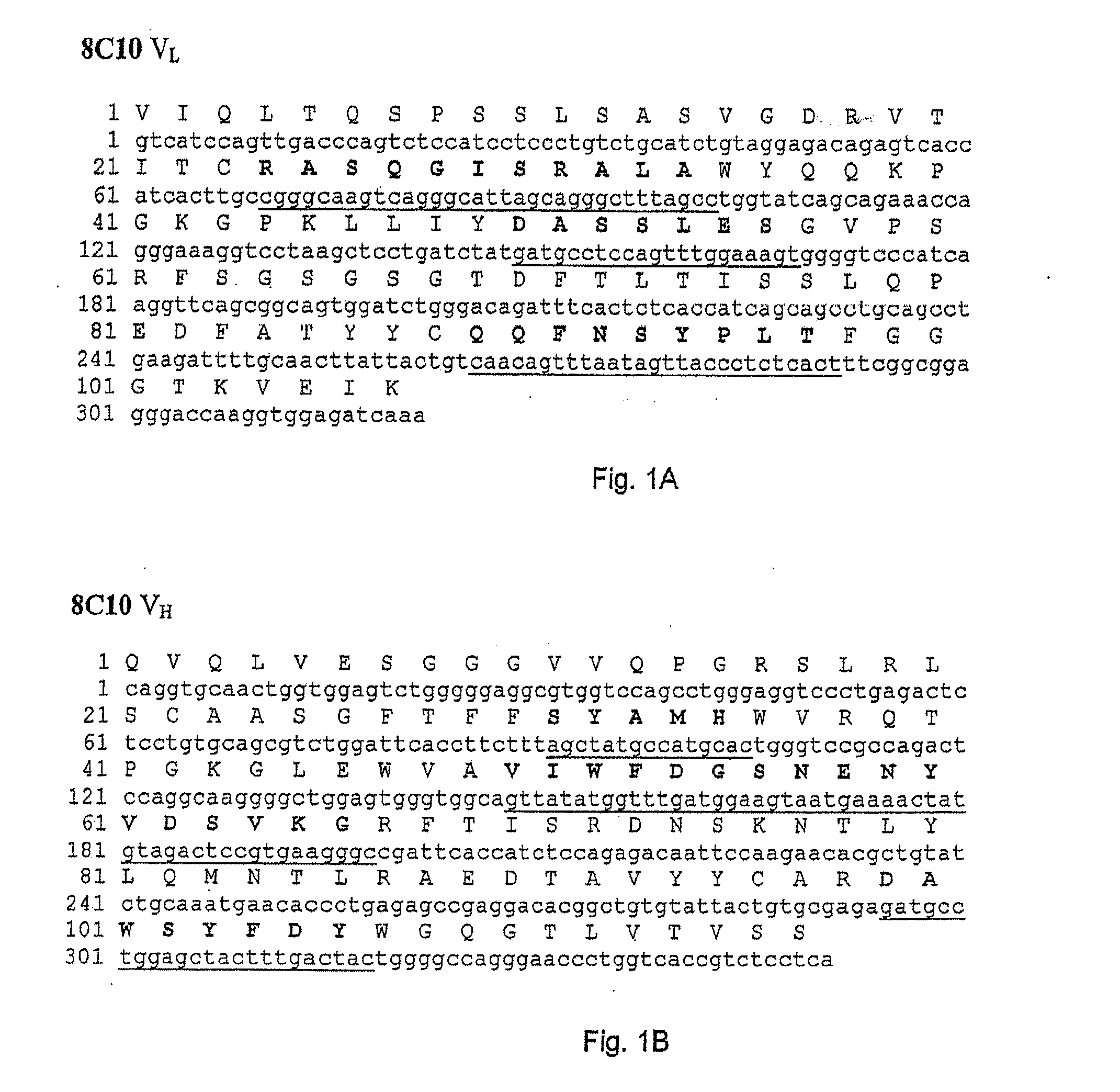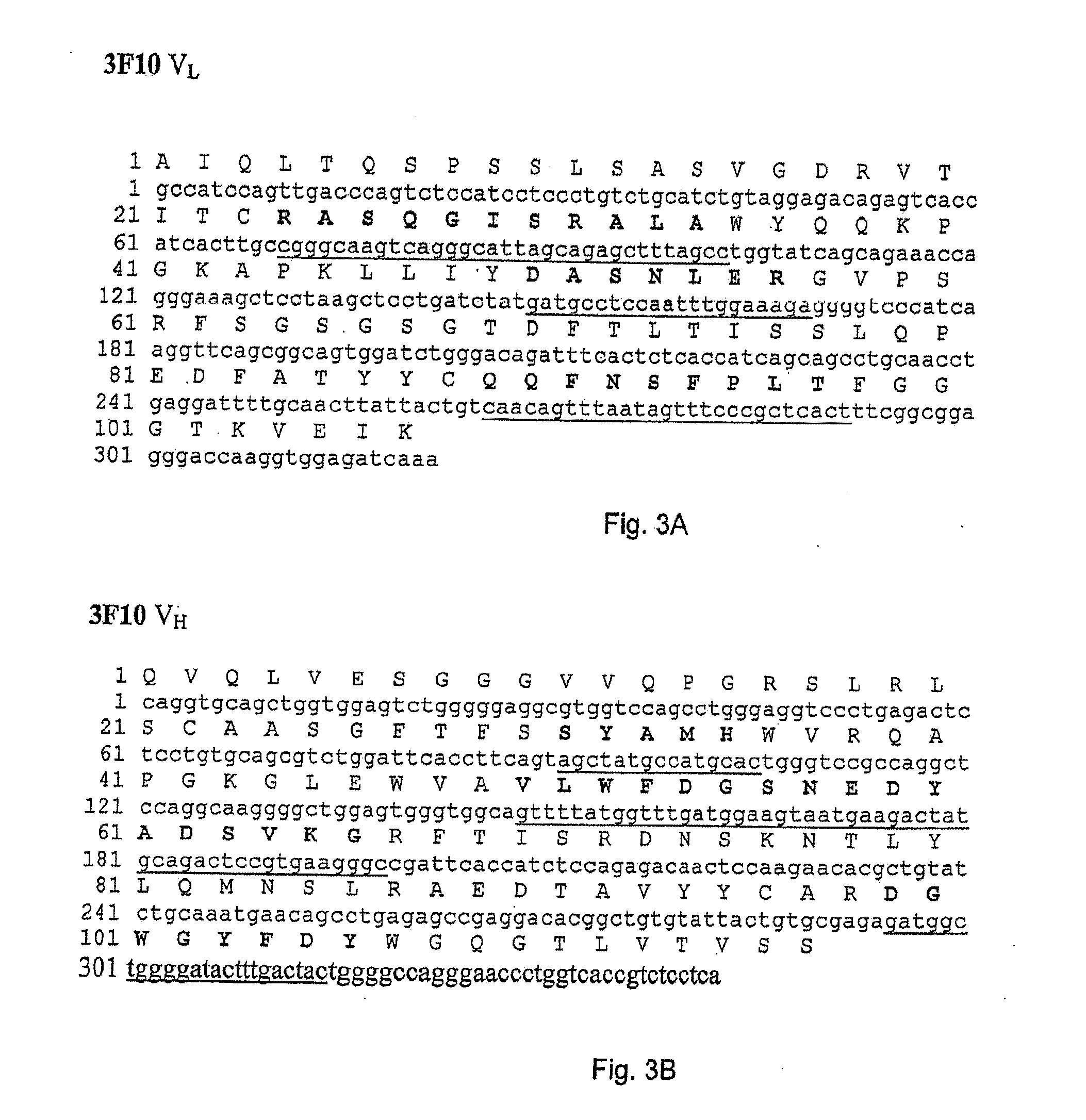Fully human Anti-vap-1 monoclonal antibodies
a monoclonal antibody, fully human technology, applied in the field of nucleic acid sequences encoding fully human monoclonal antibodies, can solve the problems of limited potential of murine mabs as therapeutics, infiltration can in itself be damaging, and immune reaction is a major limitation of murine antibodies' use, so as to reduce immunogenicity and improve pharmacological properties.
- Summary
- Abstract
- Description
- Claims
- Application Information
AI Technical Summary
Benefits of technology
Problems solved by technology
Method used
Image
Examples
example 1
Isolation of Human Anti-VAP-1 Monoclonal Antibody Expressing Hybridomas
[0108]A human immunoglobulin transgenic mouse strain (HUMAB MOUSE®; Medarex Inc.) was used to develop human anti-VAP-1 monoclonal antibody expressing hybridoma cells. The HUMAB MOUSE® contains human immunoglobulin gene miniloci that encode unrearranged human heavy (μ and γ) and κ light chain immunoglobulin sequences, together with targeted mutations that inactivate the endogenous μ and κ chain loci (see e.g., Lonberg, et al. (1994) Nature 368(6474): 856-859). Accordingly, the mice exhibit reduced expression of mouse IgM or K, and in response to immunization, the introduced human heavy and light chain transgenes undergo class switching and somatic mutation to generate high affinity human IgG κ monoclonal antibody. The preparation and use of HuMab mice, and the genomic modifications carried by such mice, is described e.g. in U.S. Pat. Nos. 5,545,806; 5,569,825; 5,625,126; 5,633,425; 5,789,650; 5,877,397; 5,661,016;...
example 2
VAP-1 Binding Properties of the Fully Human Antibodies 5F12, 4B3, 3F10, 8A4 and 8C10
[0112]A time-resolved immunofluorometric assay was used quantitatively to examine the binding of 5F12, 4B3, 3F10, 8A4 and 8C10 to rhVAP-1. A microtiter plate was coated with rhVAP-1 and then blocked with bovine serum albumin solution. An amount of antibody between 2 and 4320 ng / ml was subsequently added to bind to rhVAP-1 and the bound antibody detected by a europium-conjugated mouse anti-human antibody (Perkin Elmer Inc.). The label was detected by measuring the time-resolved fluorescence (VICTOR3™ multilabel counter, PerkinElmer Inc.) at 615 nm. The fluorescence counts directly correlate with how much antibody was bound to its target. The sample data were then analyzed in comparison to the standard curve of a reference. The data show that 5F12, 4B3, 3F10, 8A4 and 8C10 bind to rhVAP-1 and the affinities (Kd) are shown in Table 3.
TABLE 3Binding of 5F12,4B3, 3F10, 8A4and 8C10 mAbs to rhVAP-1mAbKd (nM)...
example 3
cDNA Preparation, Cloning and Sequencing of the Variable Regions of the Fully Human Antibodies 5F12, 4B3, 3F10, 8A4 and 8C10
[0113]In order to construct recombinant antibodies, the cDNAs encoding the human heavy and light chains variable regions from the antibodies obtained in Example 1 were isolated and cloned into plasmid vectors for sequence analysis.
[0114]cDNA clones of human immunoglobulin (Ig) heavy chain variable (VH) and light chain variable (VL) regions were derived from the anti-VAP-1 expressing hybridoma cells 5F12, 4B3, 3F10, 8A4 and 8C10 in the following way. Total RNA was prepared from 5×106 hybridoma cells using the RNEASY® kit from Qiagen. VL and VH cDNAs were prepared by reverse transcription of RNA followed by “rapid amplification of cDNA ends (RACE)” procedure using “SMART™ RACE cDNA amplification kit” and high fidelity “ADVANTAGE®-HF 2 PCR kit” from BD Biosciences Clontech. The PCR amplified products were then purified, cloned into vector pCR4-TOPO® TA (Invitrogen...
PUM
 Login to View More
Login to View More Abstract
Description
Claims
Application Information
 Login to View More
Login to View More - R&D
- Intellectual Property
- Life Sciences
- Materials
- Tech Scout
- Unparalleled Data Quality
- Higher Quality Content
- 60% Fewer Hallucinations
Browse by: Latest US Patents, China's latest patents, Technical Efficacy Thesaurus, Application Domain, Technology Topic, Popular Technical Reports.
© 2025 PatSnap. All rights reserved.Legal|Privacy policy|Modern Slavery Act Transparency Statement|Sitemap|About US| Contact US: help@patsnap.com



